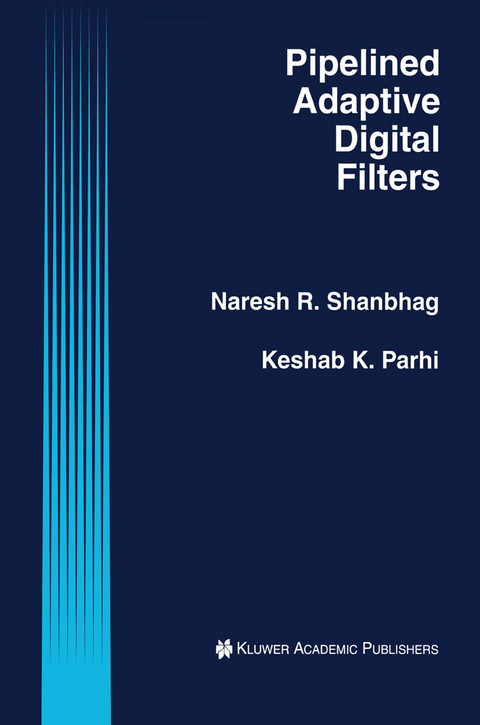
Pipelined Adaptive Digital Filters
Springer (Verlag)
978-0-7923-9463-1 (ISBN)
Pipelined Adaptive Digital Filters is required reading for all users of adaptive digital filtering algorithms. Algorithm, application and integrated circuit chip designers can learn how their algorithms can be tailored and implemented with lower area and power consumption and with higher speed. The relaxed look-ahead techniques are used to design families of new topologies for many adaptive filtering applications including least mean square and lattice adaptive filters, adaptive differential pulse code modulation coders, adaptive differential vector quantizers, adaptive decision feedback equalizers and adaptive Kalman filters. Those who use adaptive filtering in communications, signal and image processing algorithms can learn the basis of relaxed look-ahead pipelining and can use their own relaxations to design pipelined topologies suitable for their applications.
Pipelined Adaptive Digital Filters is especially useful to designers of communications, speech, and video applications who deal with adaptive filtering, those involved with design of modems, wireless systems, subscriber loops, beam formers, and system identification applications. This book can also be used as a text for advanced courses on the topic.
1 Introduction.- 1.1 Background.- 1.2 Pipelining.- 1.3 Relaxed Look-Ahead.- 1.4 Outline.- 2 A Pipelined Adaptive Lattice Filter Architecture.- 2.1 Introduction.- 2.2 Pipelining Using Relaxed Look-ahead.- 2.3 Pipelined Adaptive Lattice Architectures.- 2.4 Convergence Analysis.- 2.5 Pipelined ADPCM Video Codec.- 2.6 Simulation Results.- 2.7 Conclusions.- Appendix A: Derivation of the Bounds on,Q for Convergence.- Appendix B: Derivation of the Convergence Time-Constants.- Appendix C: Derivation of the Misadjustment Expressions.- 3 Relaxed Look-Ahead Pipelined Lms Adaptive Filters and Quantizers.- 3.1 Introduction.- 3.2 The Relaxed Look-Ahead Technique.- 3.3 The PIPLMS Architecture.- 3.4. Convergence Properties Of The PIPLMS.- 3.5 The Pipelined ADPCM Codec.- 3.6 Pipelined Adaptive Quantizers.- 3.7 Simulation Results.- 3.8 Conclusions.- Appendix A: Derivation of the Misadjustment Expression andBounds on µ for Convergence.- Appendix B: Derivation of the Convergence Time-Constants.- Appendix C.- 4 A Pipelined Adaptive Differential Vector Quantizer Architecture Anda Design Algorithm.- 4.1 Introduction.- 4.2 The Pipelined ADVQ Architecture.- 4.3 Design Algorithms for PIPADVQ.- 4.4 Simulation Results.- 4.5 Speech Coding.- 4.6 Conclusions.- Appendix A.- 5 Fine-Grain Pipelined Adaptive Dfe Architectures using Relaxedlook-Ahead.- 5.1 Introduction.- 5.2 The Relaxed Look-Ahead.- 5.3 Pipelined ADFE Architectures.- 5.4 Performance Analysis.- 5.5 Convergence Analysis.- 5.6 Simulation Results.- 5.7 Conclusions.- Appendix A: Convergence Analysis.- 6 Finite-Precision Analysis of The Pipelined Adpcm Coder.- 6.1 Introduction.- 6.2 Roundoff Error Analysis.- 6.3 Simulation Results.- Appendix A: Derivation of the Expression for the MSE.- 7 Vlsi Implementation of a 100 Mhzpipelined Adpcm CodecChip.- 7.1 Introduction.- 7.2 Architecture and Timing.- 7.3 Circuit Modules and Floor-Plan.- 7.4 Design Methodology.- 7.5 Conclusions.- 8 A Pipelined Kalman Filter Architecture.- 8.1 Introduction.- 8.2 The Pipelined Kalman Filter.- 8.3 Simulation Results.- 8.4 Folded Architecture.- 8.5 Conclusions.- Appendix A: Derivation of the PIPKAL Algorithm.- Appendix B: Convergence Analysis.- 9 Future Research Directions.- 9.1 Summary.- 9.2 Future Research.- 10 References.
| Erscheint lt. Verlag | 30.6.1994 |
|---|---|
| Reihe/Serie | The Springer International Series in Engineering and Computer Science ; 274 |
| Zusatzinfo | XII, 187 p. |
| Verlagsort | Dordrecht |
| Sprache | englisch |
| Maße | 155 x 235 mm |
| Themenwelt | Mathematik / Informatik ► Informatik |
| Naturwissenschaften ► Physik / Astronomie ► Mechanik | |
| Technik ► Elektrotechnik / Energietechnik | |
| ISBN-10 | 0-7923-9463-1 / 0792394631 |
| ISBN-13 | 978-0-7923-9463-1 / 9780792394631 |
| Zustand | Neuware |
| Haben Sie eine Frage zum Produkt? |
aus dem Bereich


